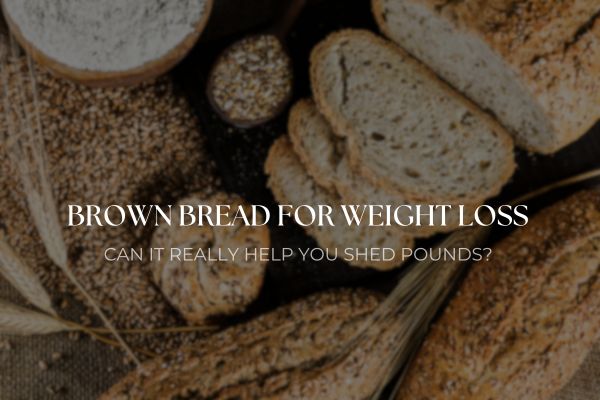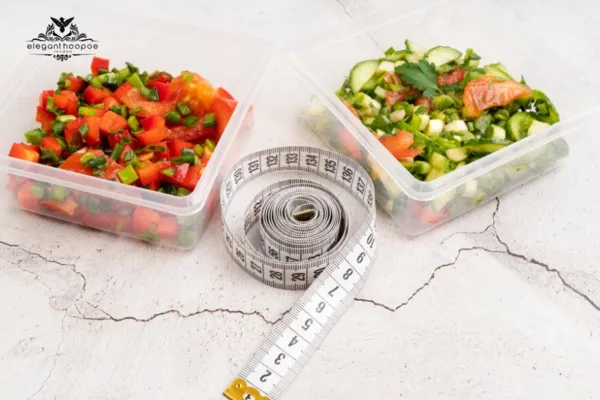Is Brown Bread Healthy for Weight Loss? Unpacking the Truth
Yes, brown bread can be a healthy choice for weight loss—if you choose the right type! Here’s why:
- High in Fiber: Keeps you full longer and supports digestion.
- Lower Glycemic Index: Helps control blood sugar levels.
- Fewer Calories: Compared to white bread, it has slightly fewer calories and less added sugar.
- Heart-Healthy: Packed with whole grains that support cardiovascular health.
For best results, pick whole-grain varieties with minimal additives and pair them with protein and healthy fats. Moderation is key!
Is brown bread a legitimate weight-loss hero, or is it just another carb-heavy impostor masquerading as a health food? You’ve probably seen it touted as the smarter alternative to white bread—praised for boosting metabolism, curbing hunger, and helping you shed those stubborn pounds. But does it really deliver on these promises, or could it be quietly undermining your efforts? In this detailed, no-nonsense guide, we’ll peel back the layers of hype and reveal the unvarnished truth about brown bread’s role in weight loss. We’ll explore its nutritional makeup, compare it to other breads, unpack the science behind its benefits, and arm you with practical strategies to make it work for you. Buckle up—we’re about to separate fact from fiction and give you the full scoop!
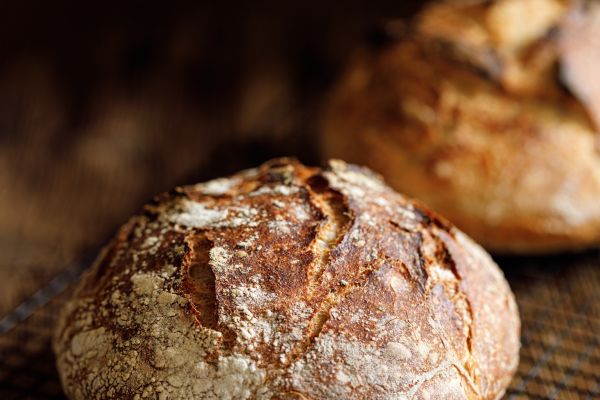
What Is Brown Bread, Anyway?
Before we dive into whether brown bread can help you slim down, let’s get clear on what it actually is. At its core, brown bread is typically made from with whole wheat flour which uses the entire wheat grain:
- Bran: The tough, fiber-packed outer shell that’s loaded with roughage.
- Germ: The nutrient-rich embryo, brimming with vitamins, minerals, and healthy fats.
- Endosperm: The starchy inner part that provides energy.
This trio makes brown bread a whole-grain powerhouse, retaining far more fiber, vitamins (like B1, B3, and B6), and minerals (think magnesium, iron, zinc, and phosphorus) than white bread, which is crafted from refined flour that ditches the bran and germ. White bread ends up as mostly simple carbs with a fraction of the nutrients—a bit like eating the frosting without the cake.
Different Types of Brown Bread
Brown bread isn’t a one-size-fits-all category. There’s a whole world of varieties out there:
- Whole Wheat Bread: Made entirely from whole wheat flour, it’s the gold standard for fiber and nutrients.
- Multigrain Bread: Combines different whole grains like oats, barley, or millet for a diverse nutrient profile and a hearty texture.
- Rye Bread: Often darker and denser, it’s made with rye flour and prized for its unique flavor and filling qualities.
- Sourdough Brown Bread: Fermented for better digestibility, it can be whole-grain based for added health perks.

The Catch: Not All Brown Bread Is Legit
Here’s where it gets tricky—some “brown bread” is a wolf in sheep’s clothing. Manufacturers might take refined white flour and dye it with molasses, caramel coloring, or even cocoa to give it that wholesome brown hue. The result? A loaf that looks healthy but lacks the whole-grain goodness. To avoid the fake-outs, flip to the ingredient list and look for “whole wheat,” “whole grain,” or “100% whole wheat” as the first item. If you see “enriched wheat flour” or “wheat flour” leading the pack, it’s not the real deal.
Did You Know?
Whole grains aren’t just about weight loss—they’re linked to a lower risk of chronic conditions like type 2 diabetes, heart disease, and even certain cancers, according to a 2016 study in the British Medical Journal. So, choosing brown bread could be a win for your waistline and your long-term health.
See also What’s a low-GI diet and will it help you lose weight?
Brown Bread vs. White Bread: A Nutritional Face-Off
To get a handle on brown bread’s weight-loss potential, let’s pit it against its pale rival, white bread, in a detailed nutritional showdown. Here’s how they stack up per slice (about 28 grams, though sizes vary slightly by brand):
| Nutrient | Brown Bread (Whole Wheat) | White Bread (Refined) |
| Calories | 74 | 98 |
| Carbohydrates | 15.1 g | 18.7 g |
| Protein | 2.9 g | 3.7 g |
| Fat | 0.7 g | 0.8 g |
| Fiber | 1.2 g | 0.9 g |
| Sugar | 0 g | 1.2 g |
| Sodium | 120 mg | 150 mg |
| Iron | 0.8 mg (4% DV) | 0.6 mg (3% DV) |
| Magnesium | 20 mg (5% DV) | 5 mg (1% DV) |
| Vitamin B6 | 0.1 mg (5% DV) | 0.02 mg (1% DV) |
| Folate | 12 µg (3% DV) | 25 µg (6% DV)* |
*DV = Daily Value based on a 2,000-calorie diet. Note: White bread’s folate is often from fortification, not natural sources.
Related Article: Endomorphs Diet
Nutritional Value of Brown Bread
- Calories: Brown bread clocks in at 74 calories per slice versus white bread’s 98. That 24-calorie difference might seem small, but over a week of daily sandwiches, it adds up to nearly 170 calories saved—enough to tip the scales in your favor.
- Fiber: With 1.2 grams per slice, brown bread edges out white bread’s 0.9 grams. Fiber is your satiety sidekick, keeping hunger at bay and reducing the urge to raid the pantry.
- Sugar: Brown bread typically has zero added sugar, while white bread’s 1.2 grams can trigger blood sugar spikes and subsequent cravings—enemy #1 for dieters.
- Carbohydrates: Brown bread’s 15.1 grams are mostly complex carbs, releasing energy slowly. White bread’s 18.7 grams are simpler, digesting fast and leaving you hungry sooner.
- Nutrients: Brown bread brings more magnesium (20 mg vs. 5 mg), vitamin B6 (0.1 mg vs. 0.02 mg), and naturally occurring iron to the table, supporting metabolism and energy levels. White bread might boast more folate, but it’s usually synthetic, added during processing.
Beyond the Basics
White bread often leans on refined flour’s quick-digesting nature, which can leave you sluggish after the initial energy spike. Brown bread, with its whole-grain foundation, offers sustained fuel and a nutty flavor that doesn’t need heavy spreads to shine. Plus, its higher fiber content means better digestion—less bloating, more comfort.
Key Takeaway: Brown bread’s lower calories, higher fiber, and richer nutrient profile make it a standout choice for weight loss. But don’t be fooled by impostors—always double-check that it’s genuinely whole grain.
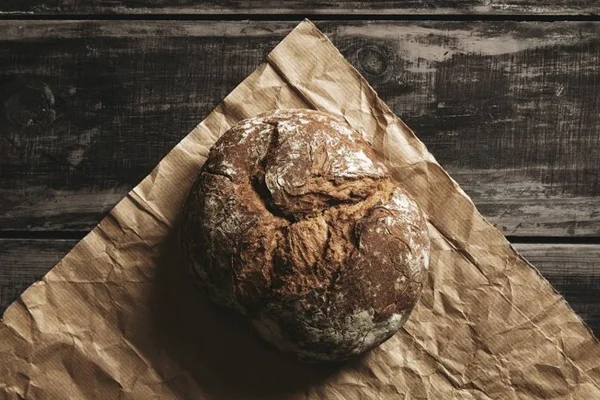
Benefits of Brown Bread for Weight Loss
Brown bread isn’t just a lighter swap for white—it’s got a lineup of benefits that can actively propel you toward your weight-loss goals. Let’s unpack the science and practical perks that make it a contender:
Lower Glycemic Index (GI) for Blood Sugar Control
- Whole wheat brown bread has a GI of 56-69, compared to white bread’s 70+. Lower GI means slower digestion and a gentler rise in blood sugar, dodging the hunger pangs that hit after a high-GI crash. A 2018 study in Diabetes Care found that low-GI diets can improve insulin sensitivity, a bonus for fat loss.
Fiber: Your Hunger-Busting Hero
- At 1.2-2 grams per slice (and up to 5 grams in some high-fiber loaves), brown bread’s fiber fills you up and keeps you there. It bulks up in your stomach, slows digestion, and even binds to some calories, ushering them out before they’re absorbed. Research from the Journal of Nutrition shows high-fiber diets can cut daily calorie intake by up to 200 calories—huge for weight loss!
Heart Health Boost
- Whole grains lower LDL (“bad”) cholesterol and reduce heart disease risk, per the American Heart Association. A healthier ticker means you can sustain the workouts that burn fat.
Steady Energy for an Active Life
Complex carbs in brown bread release energy gradually, avoiding the rollercoaster of white bread’s refined carbs. Whether you’re hitting the gym or chasing kids, this steady fuel keeps you moving—and burning calories. So, if you care about weight and inch loss, don’t forget to incorporate brown bread into your diet.
Gut Health Gains
Fiber doesn’t just fill you up—it feeds your gut’s good bacteria, fostering a balanced microbiome. A 2020 study in Gut Microbes linked a healthy gut to better metabolism and less bloating, so you feel lighter and leaner.
Metabolism-Friendly Nutrients
B vitamins (like B6 and folate) and magnesium in brown bread power your body’s energy production, while antioxidants combat inflammation that can stall weight loss. A revved-up metabolism burns more calories, even when you’re Netflix-and-chilling.
Meal Versatility
Brown bread adapts to endless healthy combos—think avocado toast with a poached egg, a turkey-and-veggie sandwich, or even a light PB&J with natural peanut butter and fresh berries. It’s a canvas for low-calorie creativity.
Psychological Win
Unlike restrictive diets that ban bread, including brown bread keeps you sane and satisfied. “Bread is comfort food,” says nutritionist Sarah Johnson. “A whole-grain version lets you enjoy it without guilt.”
Science Spotlight: A 12-week study in the American Journal of Clinical Nutrition found that swapping refined grains for whole grains reduced body fat by 1-2%—proof that brown bread can play a starring role in your slim-down plan.
The Best Bread Types for Weight Loss
| Bread Type | Glycemic Index (GI) | Fiber Content | Nutrient Density | Weight Loss Consideration |
| Whole Grain Bread | Moderate (56-69) | High | High (vitamins, minerals) | It provides steady energy release, helping to control hunger. Choose options with minimal added sugar for better blood sugar control. |
| Sprouted Grain Bread | Low (40-55) | High | Very High (protein, vitamins) | It has a lower GI due to the sprouting process. Its high fiber and protein content help improve satiety, making it a great choice for dieters. |
| Rye Bread | Low (41-55) | High | High (magnesium, B vitamins) | Lower GI naturally slows digestion and promotes fullness. Be mindful of portion sizes; some commercial rye breads may include added sugars. |
| Sourdough Bread | Low-Moderate (48-60) | Moderate | Moderate (minerals, probiotics) | Fermentation lowers GI, making it easier to digest and less likely to cause blood sugar spikes. For added fiber, opt for whole-grain sourdough. |
| Quinoa/Buckwheat Bread | Low (35-50) | Moderate-High | High (complete proteins) | Quinoa and buckwheat are gluten-free grains with low GI. They provide protein, which aids muscle preservation during weight loss. Look for whole-grain options to boost fiber intake. |
| Thin Sliced Bread | Varies (depends on type) | Low-Moderate | Low-Moderate | Lower calorie per slice, but check the fiber content. Opt for whole grain versions with no added sugars to keep blood sugar levels balanced. |
| Low-Calorie Wraps | Varies (depends on type) | Low-Moderate | Moderate (depends on brand) | They are often lower in GI due to thinner portions. They can be an intelligent swap if you want to reduce overall calorie intake, but ensure you pick whole-grain versions for better satiety. |
| Lettuce Wraps | N/A | None | High (vitamins, water content) | Zero-carb alternative that eliminates glycemic impact. It helps reduce calorie intake and boosts hydration but lacks the fiber and nutrients in grain-based breads. |
Bread doesn’t have to be your diet’s villain. The right loaf can be a trusty sidekick. Here’s a rundown of the top picks for weight loss, complete with why they work and how to spot them:
Whole-Grain Bread
- Why It’s Great: Packed with fiber (2-5 g per slice) and nutrients, it’s the baseline for healthy bread.
- How to Choose: Look for “100% whole grain” or “whole wheat” first on the label. Brands like Pepperidge Farm Whole Grain are solid picks.
Sprouted Grain Bread
- Why It’s Great: Sprouting reduces starches, lowers glycemic index (40-55), and ups protein and vitamins. It’s easier to digest, too.
- Try This: Ezekiel 4:9 bread, made from sprouted wheat, barley, and lentils, is a fan favorite.
Rye Bread
- Why It’s Great: Its low GI (41-55) and 2-3 grams of fiber per slice keep you full. A 2017 study in Nutrition Journal found rye bread eaters reported less hunger than wheat bread fans.
- Pro Tip: Go for 100% rye—blends with white flour dilute the benefits.
Sourdough Bread
- Why It’s Great: Fermentation drops its GI (48-60) and boosts digestibility. Whole-grain sourdough doubles down on fiber.
- Fun Fact: The tangy taste comes from lactic acid bacteria, which also pre-digest some carbs for you.
Quinoa or Buckwheat Bread
- Why It’s Great: Low GI (35-50), gluten-free, and protein-rich (4-6 g per slice), these support muscle maintenance during weight loss.
- Where to Find: Check health food stores or bake your own with quinoa flour.
Bonus: Flaxseed Bread
- Why It’s Great: Adds omega-3s and extra fiber (3-4 g per slice) for heart and gut health.
- Taste Twist: Its nutty flavor pairs perfectly with savory toppings.
Shopper’s Note: Look for artisan or bakery-fresh options—mass-produced breads might skimp on quality. Smell it, feel it—a good loaf has a hearty aroma and slight heft.
See also Can a Bad Diet Cause Hair Loss?
How to Pick the Perfect Bread for Weight Loss
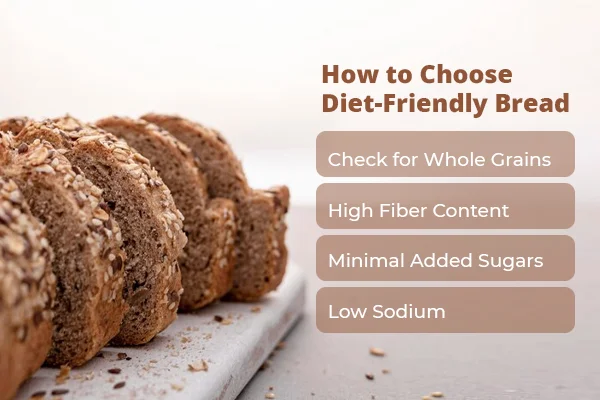
The bread aisle can feel like a maze of marketing traps. Here’s your foolproof guide to snagging a loaf that supports your goals:
- Go Whole Grain
- “Whole wheat” or “whole grain” should top the ingredient list. Skip anything starting with “enriched flour”—it’s refined flour in disguise.
- Fiber First
- Aim for 2-5 grams per slice. More fiber = more fullness. Some sprouted or rye breads hit the high end.
- Sugar Check
- Keep added sugars below 2 grams per slice. Watch for sneaky aliases like “cane syrup” or “honey” in excess.
- Sodium Watch
- Cap it at 150 mg per slice. Too much sodium can cause water retention, masking your progress.
- Calorie Count
- Stick to 70-100 calories per slice. Thin-sliced options (around 50 calories) are great for extra wiggle room.
- Keep It Simple
- A short ingredient list—flour, water, yeast, salt—is ideal. Avoid preservatives like calcium propionate or artificial dough conditioners.
- Certifications Count
- “Organic,” “non-GMO,” or “Whole Grain Council” stamps signal quality. They’re not essential but add credibility.
- Texture Test
- A dense, chewy loaf often means more whole grains and less fluff. Ultra-soft “brown bread” might be a processed pretender.
Pitfall to Avoid: Don’t trust the color alone. Caramel-tinted white bread is a common trick—ingredients tell the real story.
Pro Tip: “When in doubt, ask the baker,” advises dietitian Mark Taylor. “Local bakeries often spill the beans on what’s in their loaves.”
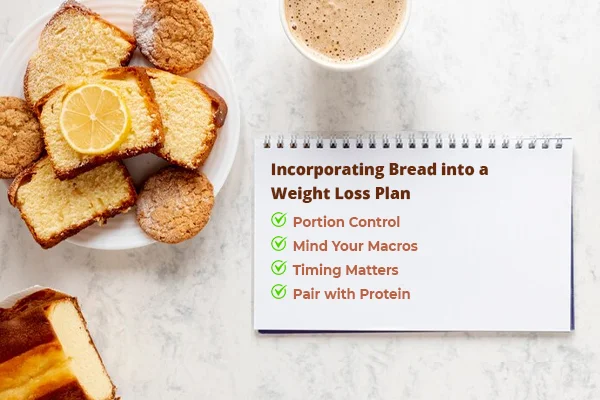
Best Ways to Incorporate Brown Bread in Your Diet
Bread lovers, rejoice—you can keep it in your life and still lose weight. Here’s how to savor brown bread strategically:
- Portion Smart: One slice (70-100 calories) per meal is plenty. Use a food scale or pre-slice to avoid eyeballing errors.
- Balance It Out: Pair with lean proteins (turkey, grilled chicken, tofu) and healthy fats (avocado, a drizzle of olive oil) for a complete, filling meal.
- Timing Matters: Eat bread at breakfast or lunch when you’re active, not as a midnight snack when calories might stick around.
- Topping Game: Swap calorie bombs like butter or sugary spreads for these:
- Avocado Smash: ¼ avocado, chili flakes, and a pinch of sea salt.
- Hummus Delight: 2 tbsp hummus with cucumber and tomato slices.
- Salmon Lite: 1 oz smoked salmon, lemon juice, and fresh dill.
- Nut Butter Boost: 1 tbsp almond butter with thin apple slices.
- Recipe Ideas:
- French Toast Twist: Dip in egg whites, cook with cinnamon, and top with Greek yogurt and berries (under 200 calories).
- Open-Face Power: Layer with grilled veggies, a sprinkle of feta, and a balsamic drizzle.
- Mini Pizzas: Spread tomato paste, add spinach and low-fat mozzarella, then bake.
Meal Plan Example:
- Breakfast: 1 slice whole-grain toast, 1 tbsp peanut butter, ½ banana (250 cal).
- Lunch: 1 slice rye bread, 3 oz turkey, lettuce, mustard (300 cal).
- Snack: 1 slice sprouted bread, 2 tbsp hummus, carrots (200 cal).
Lighten Up: Try thin-sliced bread (50-70 cal) or swap one slice for a lettuce wrap to cut carbs without losing flavor.
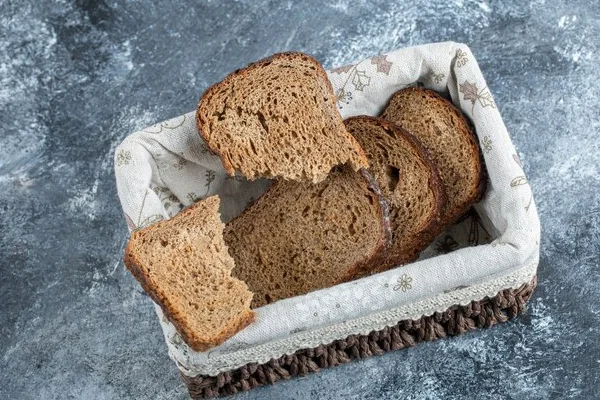
Busting Common Bread Myths
Bread gets a lot of flak, often unfairly. Let’s debunk the biggest myths with facts:
- Myth: “Bread always makes you gain weight.” Truth: Whole-grain brown bread, in moderation, fits a weight-loss diet. It’s excess calories—not bread itself—that pack on pounds.
- Myth: “Bread equals belly fat.” Truth: No food targets belly fat—total calorie surplus does. Brown bread’s fiber can actually help you eat less overall.
- Myth: “Gluten-free is always better.” Truth: Unless you’re gluten-intolerant, whole-grain bread often beats gluten-free in fiber and nutrients. Many GF breads use starchy fillers.
- Myth: “Carbs are the devil.” Truth: Complex carbs in brown bread fuel your body and brain. A 2019 Lancet study found moderate carb intake (40-50% of calories) supports longevity.
- Myth: “Brown bread is just dyed white bread.” Truth: True brown bread is whole grain—check labels to avoid fakes dyed with molasses.
Expert Take: “People fear bread, but it’s about quality,” says nutritionist Dr. Lisa Hayes. “Whole grains are a gift—don’t toss them out over myths.”
The Bottom Line: Is Brown Bread Good for Weight Loss?
Yes, brown bread can be a stellar ally in your weight-loss quest—if you pick the right loaf and eat it wisely. Its fiber keeps you full, its lower GI stabilizes blood sugar, and its nutrients fuel your metabolism. Compared to white bread, it’s a nutritional champ. But it’s not magic—pair it with a balanced diet, regular movement, and smart habits to see the scale budge.
Next grocery trip, snag a whole-grain brown bread, scrutinize the label, and enjoy it guilt-free. Whether it’s a hearty sandwich or a light toast, it’s a small change with big potential.
Your Next Step: Curious about boosting your weight-loss efforts? Check out our best noninvasive fat removal methods like Venus Bliss, at elegant hoopoe’s clinic in Dubai. Book a consultation and kickstart your transformation with our diet expert support!


